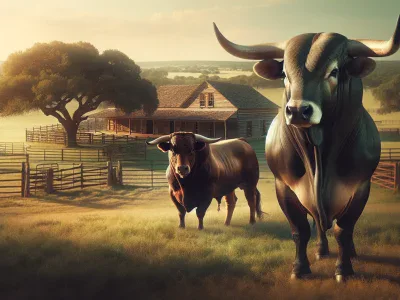Understanding the Difference Between FFA and 4-H: Which Youth Program Is Right for You?
Picture standing in a bustling barn, the scent of fresh hay mixing with the hum of excited voices. On one side, students proudly showcase their livestock under the banner of FFA; on the other, 4-H members demonstrate hands-on projects that go beyond agriculture. Both programs are rooted in leadership and community, yet they offer distinct paths for personal growth and skill-building.
If you’ve ever wondered which program aligns best with your goals—or those of someone you know—you’re not alone. While FFA emphasizes agricultural education within schools, 4-H opens doors to a broader range of interests through extracurricular activities. Understanding these differences can help you choose the right fit for cultivating passions and building lifelong skills.
Overview Of FFA And 4-H
FFA and 4-H are two prominent youth organizations in the United States, each offering unique opportunities for personal development. Both focus on fostering skills and leadership but differ in their specific approaches and scopes.
What Is FFA?
Founded in 1928, FFA (Future Farmers of America) emphasizes agricultural education. It’s designed for students in grades 7-12 enrolled in agricultural science programs. The organization combines classroom learning with hands-on experiences like supervised agricultural projects (SAEs). These include activities such as raising livestock, growing crops, or managing agribusiness ventures.
FFA’s structure is rooted in its motto: “Learning to Do, Doing to Learn, Earning to Live, Living to Serve.” It hosts events like career development competitions that sharpen technical and leadership skills. Members often wear the iconic blue corduroy jacket during these events. With over 850,000 members nationwide as of 2023 (source: National FFA Organization), it provides pathways into careers related to agriculture and beyond.
What Is 4-H?
4-H began earlier than FFA—in the early 1900s—and operates under USDA oversight through local land-grant universities. Unlike FFA’s concentration on agriculture, 4-H supports a broader range of interests spanning STEM fields, arts, healthy living initiatives, and community service.
Membership includes children aged 5-19 who participate in projects tailored to their passions. Examples range from robotics workshops and photography contests to gardening clubs or public speaking events. Its slogan “Learn by Doing” reflects its experiential approach—encouraging skill-building through practice rather than theory alone.
With over six million members across rural areas as well as urban hubs (source: USDA), it fosters inclusivity while promoting civic responsibility alongside individual growth ambitions.
Historical Background
Understanding the origins of FFA and 4-H provides insight into their distinct missions and contributions to youth development in the U.S.
Origins Of FFA
FFA, established in 1928, emerged to address the growing need for agricultural education in schools. Rooted in Virginia, its founding aimed to prepare young people for careers in farming and related industries during a time when agriculture played a vital role in the national economy. The organization initially limited membership to male students but expanded inclusivity over time.
The Smith-Hughes Act of 1917 catalyzed agricultural education programs that later influenced FFA’s creation. By combining classroom instruction with practical learning through Supervised Agricultural Experiences (SAEs), FFA became instrumental in equipping students with real-world skills. Its iconic blue corduroy jacket symbolizes unity among members nationwide.
Origins Of 4-H
4-H traces its beginnings back to rural Midwest communities around 1902, focusing on bridging generational gaps between adult farmers and younger learners. Early programs emphasized hands-on activities like crop cultivation and livestock care as a means of introducing scientific farming techniques.
Under USDA guidance since 1914, following the establishment of Cooperative Extension Services through the Smith-Lever Act, 4-H expanded its scope beyond agriculture. Today, it encompasses diverse interests such as robotics, environmental science, performing arts, and civic engagement while retaining its foundational “learn by doing” philosophy.
Through local clubs led by volunteers or extension agents, you see how it nurtures creativity alongside leadership skills across urban and rural settings alike.
Key Areas Of Focus
FFA and 4-H differ in their primary areas of focus, shaping how they guide youth development and education.
Educational Goals Of FFA
FFA concentrates on agricultural education, preparing students for careers in farming, agribusiness, and related industries. Through supervised agricultural experiences (SAEs), you engage in hands-on projects like raising livestock or growing crops. Leadership development is central to FFA’s mission; activities such as public speaking contests and officer roles help you build confidence and communication skills.
The curriculum aligns with STEM principles by incorporating technology into modern farming practices. For example, precision agriculture using drones or data analysis tools becomes part of your learning journey. By connecting classroom instruction with real-world applications, FFA fosters technical expertise alongside leadership abilities.
Educational Goals Of 4-H
In contrast to FFA’s specialized approach, 4-H promotes a broader spectrum of interests beyond agriculture. You explore topics like robotics, creative arts, environmental science, or community service through project-based learning. This diversity enables personal growth tailored to your unique interests.
Volunteer-led clubs emphasize mentorship while encouraging teamwork among peers. The “Learn by Doing” philosophy ensures that practical experience complements theoretical knowledge—whether you’re coding software for a STEM competition or organizing a neighborhood cleanup initiative.
Unlike FFA’s school-based structure, 4-H operates within local communities under USDA oversight. Its flexibility makes it accessible regardless of whether schools offer specific programs related to its themes.
Membership And Structure
Both FFA and 4-H offer unique membership opportunities and organizational frameworks designed to support youth development. Understanding these differences helps you identify which program aligns with your interests or those of someone you know.
Who Can Join FFA?
FFA accepts students enrolled in grades 7-12 who are part of a school offering agricultural education courses. Membership requires active enrollment in an agriculture class, as FFA functions as an intracurricular component of the school system. If you’re passionate about farming, agribusiness, or leadership within agriculture-focused industries, this program caters directly to those goals.
With over 850,000 members nationwide (as of 2023), FFA provides access to career-building resources like supervised agricultural experiences (SAEs) and leadership events. Students often wear the iconic blue corduroy jacket at competitions, embodying unity and tradition while showcasing their skills.
Who Can Join 4-H?
4-H welcomes children aged 5-19 from diverse backgrounds through local clubs managed by volunteers. Unlike FFA’s focus on agriculture courses within schools, participation in 4-H doesn’t depend on academic programs. You can explore various projects such as robotics, environmental science, creative arts, or community service regardless of your schooling environment.
Approximately six million youth participate annually across urban and rural settings under USDA guidance. For example: A child interested in coding might join a STEM-focused club while another explores gardening techniques through hands-on workshops facilitated by local mentors.
Organizational Structure Comparison
FFA operates primarily through schools as part of its agricultural education framework. Local chapters tie into state associations and a national organization led by elected officers who coordinate events like conventions and contests. Members engage in structured activities linked closely to their coursework, creating an integrated learning experience.
In contrast, 4-H functions outside the traditional classroom setting via community-based clubs supported by county extension offices under USDA oversight. Volunteer leaders organize meetings tailored to members’ interests without formal academic constraints—making it more flexible for participants pursuing varied hobbies or skills beyond agriculture alone.
Activities And Programs
FFA and 4-H offer distinct activities tailored to their missions, promoting leadership, skill development, and community engagement. These programs provide opportunities for hands-on learning and personal growth.
Common Activities In FFA
FFA emphasizes agricultural education through diverse activities. Members participate in Supervised Agricultural Experiences (SAEs) such as managing livestock or growing crops. For example, you might raise cattle or maintain a greenhouse project to learn about environmental sustainability.
Career Development Events (CDEs) test practical skills in areas like agronomy, veterinary science, and food production. Picture competing in an agriscience fair where your research on soil quality impacts farming efficiency.
Leadership training events also play a significant role. You engage in public speaking contests or attend national conventions that foster networking with peers nationwide.
Common Activities In 4-H
4-H focuses on broader fields beyond agriculture, offering projects in STEM, arts, health, and civic involvement. Robotics competitions let you design functional machines while enhancing teamwork skills.
Community service is integral; participants organize initiatives like food drives or park cleanups to address local needs directly impacting neighborhoods.
Creative endeavors include photography workshops and drama clubs fostering artistic expression alongside technical knowledge sharing at county fairs.
Both organizations provide unique platforms designed to align with individual interests while encouraging active participation in meaningful ways.
Career Preparation And Skill Development
Both FFA and 4-H provide valuable career preparation and skill development opportunities, tailored to their unique focus areas. Each organization equips members with practical experiences that foster personal growth and professional readiness.
Opportunities Through FFA
FFA emphasizes agricultural education while integrating leadership training. Members participate in Supervised Agricultural Experiences (SAEs), which include managing livestock, growing crops, or conducting research projects. For example, you might experiment with hydroponics to study sustainable farming methods. These hands-on activities build technical proficiency crucial for careers in agronomy, animal science, and agribusiness.
Career Development Events (CDEs) further enhance your skills by simulating real-world tasks. CDEs cover topics like veterinary science, forestry management, and agricultural sales. If you’re interested in public speaking or debate, events such as Extemporaneous Speaking sharpen communication abilities essential for diverse professions.
FFA also collaborates with industry partners to offer scholarships and internships. By attending national conventions or leadership workshops, you gain networking opportunities that connect you with agriculture professionals who can guide your career path.
Opportunities Through 4-H
4-H prepares youth for various fields through project-based learning across multiple disciplines like STEM (science, technology, engineering, mathematics), the arts, and community service. You could join a robotics team to design automated systems or create a mural addressing environmental conservation themes.
Volunteer-led clubs encourage mentorship and teamwork within local communities. For instance, organizing a neighborhood clean-up teaches resource management while fostering civic responsibility—skills applicable beyond any single career field.
Youth leadership programs in 4-H develop decision-making abilities through roles such as club president or event coordinator. Statewide competitions expand your exposure to problem-solving scenarios tied directly to academic interests like coding challenges or science fairs.
Also, partnerships between 4-H and organizations like NASA support advanced educational initiatives that align with cutting-edge industries. Participants often explore careers linked not only to agriculture but also alternative energy solutions or digital innovation trends shaping global markets today.
Community Impact
FFA and 4-H shape communities by fostering leadership, service, and active involvement in local initiatives. Both organizations encourage contributions that strengthen community connections while addressing unique societal challenges.
Contributions of FFA
FFA focuses on agricultural impact through education and service projects. Members often engage in food donation drives or create sustainable farming practices to support their communities. For instance, an FFA chapter might collaborate with local farmers to organize a produce distribution event for low-income families. Leadership activities like National Days of Service allow members to address pressing issues such as hunger or environmental sustainability.
By integrating modern technology, FFA enhances its outreach efforts. Students use tools like GIS mapping to assess soil health or drones for crop monitoring during collaborative projects with local businesses. These actions not only improve agricultural productivity but also build stronger ties between youth leaders and their communities.
Contributions of 4-H
4-H emphasizes broader civic engagement beyond agriculture, empowering youth to tackle diverse challenges. Community clean-up initiatives, STEM workshops for underprivileged children, and public art installations are common examples of how 4-H clubs enhance neighborhoods. A group may lead a recycling campaign that educates residents about waste reduction while creating eco-friendly solutions.
Volunteerism plays a key role in 4-H’s community efforts. Mentorship programs connect experienced volunteers with young participants to guide them through impactful projects like developing urban gardens or organizing wellness fairs. This hands-on approach fosters collaboration across generations while addressing shared societal goals.
Both groups contribute uniquely toward building resilient communities through skill development and meaningful action plans led by passionate individuals working together effectively.
Conclusion
Choosing between FFA and 4-H depends on your interests, goals, and the type of experiences you want to pursue. Both organizations offer incredible opportunities for personal growth, leadership development, and community engagement. Whether you’re drawn to FFA’s focus on agricultural education or 4-H’s diverse project-based learning, each program equips you with valuable skills that can shape your future. By exploring what aligns best with your passions, you’ll find a supportive environment where you can thrive and make a lasting impact.
- Understanding the Difference Between Yield and Return: Key Insights for Investors - October 1, 2025
- Key Differences Between Saving and Checking Accounts: Which Is Right for You? - October 1, 2025
- Top 7 Substitute Options for Bay Leaf to Enhance Your Recipes - October 1, 2025







